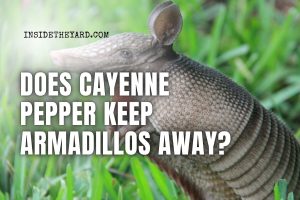Amazing Creation: Five Insects That Appear to Be Leaves
Have you ever been startled when exploring a welcoming wilderness and noticing a moving leaf? So, relax; they’re just bugs that, at first glance, look like regular old leaves.
Geckos and chameleons are known to adopt a new appearance in unfavorable conditions. However, the insects known as walking leaves are wonderful creatures that exist in their natural environments and don’t bother trying to blend in.
Their entire body coloration and shape is reminiscent of a leaf. There is a lot of interesting data on these insects, and there are many different kinds.
If you want to learn everything there is to know about leaf insects, then you should read this article all the way to the end. Insects that imitate leaves? We need to know!
Table of Contents
What are leaf insects, and how do bugs resemble leaves?
Insects that resemble leaves in every way (including color, shape, shading, and even weight) are called “leaf bugs,” or “walking leaves,” and are typically described as a striking green.
It’s only natural to wonder what the heck inspired the design of leaf bugs. Insects have evolved this strategy to protect themselves from potential enemies. The dense plant life provides these insects with excellent cover while they feed.
The Phylliidae family of the order Phasmida or Phasmatodea in the phylum Arthropoda is where you’ll find the walking leaves, also known as leaf bugs. It’s common knowledge that there are more species of arthropods than any other group of animals.
In that time, scientists have uncovered an incredible fifty unique species of Leaf insects across the planet. Though, most insects that live on leaves have similar habits and physiology.
The nature, diet, and habitat requirements of many species, however, are surprisingly diverse. The insects that are camouflaged as leaves and flowers can be conveniently classified into two groups, one based on color and the other on pattern.
There are two primary kinds of leaf-shaped bug: those that are green and those that are brown and dried.
A Bug Resembling A Green Leaf
The coloration of leaf insects resembles that of young, vibrant leaves, hence their common name. Their preferred habitats are lush green spaces like swamps, rainforests, mangroves, farmlands, and gardens.
They are difficult to spot during the day because they blend in perfectly with the foliage of a tree, and their nighttime activity makes them difficult to spot even when they are out in the open. Read on for a quick rundown on a few insect-friendly greens that could easily be mistaken for their insect counterparts.
1. Malaysian Giant Leaf Insect
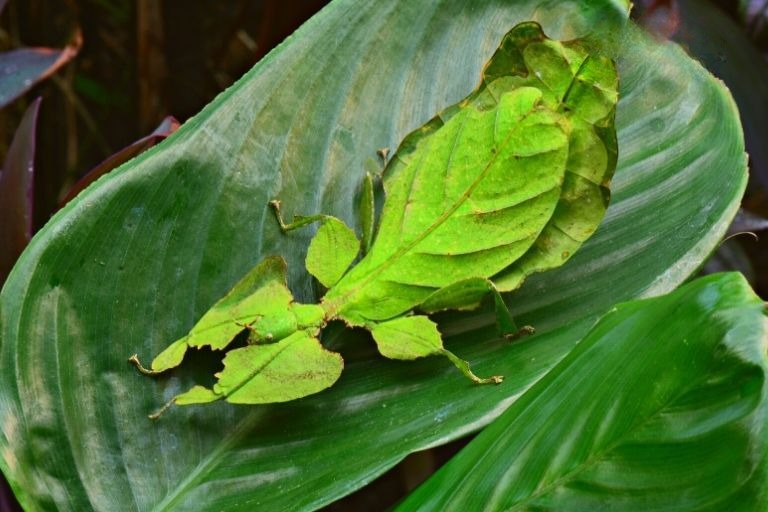
Giant Malaysian Leaf Insect (Pulchriphyllium giganteum) is the scientific name for the leaf-shaped bug. As of 2021, they are part of the genus Pulchriphyllium. At 105 mm in length, this is the largest species, Pulchriphyllium giganteum.
Environment and Sexuality
Their most common tropical habitat is Malaysia. Due to their massive, edge-to-edge elytra, female moths are usually unable to fly.
Tiny elytra and sometimes fully functional, translucent, non-leaf-like hind wings are the only distinguishing features of the male leaf insect. Typically, newly hatched nymphs are dark or reddish in color, and they do not have wings. If they eat enough leaves, they’ll start to change color.
Dietary Routines
Both the adult and the developing stage engage in a behavior known as phytophagy, in which they consume plant matter. This species relies heavily on the leaves of oak and bramble trees for sustenance.
Fascinating Information
It has been suggested that leaf mimicry plays an important role in protecting plants from predators. Such insects, like a normal leaf, have complex veining throughout their bodies. Furthermore, there are brown spots along the edges, like a damaged leaf, on it.
In order to avoid being eaten, the nymphs sway back and forth like a leaf in the wind. When rubbed together, the rows of tubercles on the antennae of some species produce noises that may scare away predators.
Importance
Green bugs that camouflage so well as leaves play a crucial role in the delicate ecological balance that sustains life on Earth. In addition to providing sustenance for various creatures, they play an important role in pollination.
There is no danger to humans from these insects, even though they tend to congregate in places far from the vegetative farmlands.
2. Katydid (Tettigoniidae)
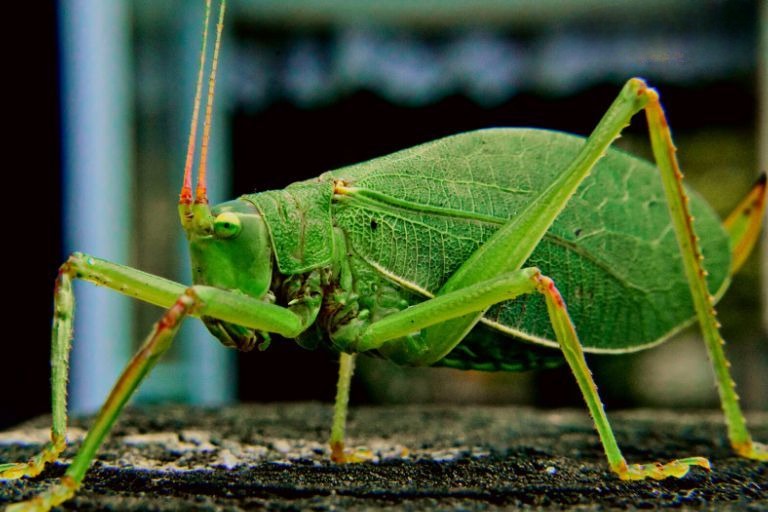
Katydids refer to any of the 6,000 or so species of primarily nocturnal insects that are closely related to crickets and are distinguished by their distinctive mating calls. Long-horned grasshoppers, also known as bush crickets, are small insects that resemble leaves. Tettigoniidae is the family that includes these insects, which look like leaves. Microcentrum rhombifolium is its official name in botany.
How to Determine Your Gender
Besides their large size and long, threadlike antennae, katydid leaf bugs are easily identified by the females’ thick, upwardly curved ovipositor. They use this process to lay eggs as well.
Food and Environment
Katydids are opportunistic feeders that will occasionally eat green leaves and other plant parts (especially flowers). Aphids and other slow-moving insects, as well as dead insects, may be consumed. Many tropical species feed almost exclusively on meat.
They rely heavily on the leaves of plants of all colors for both food and shelter. Michigan’s leaf-shaped insects are primarily found in specific environments, such as the tropics, the ground, the swamp, and the marsh. However, they may do well in a wide range of temperatures.
Fascinating facts
The front wings of all species have unique structures that can be rubbed together to make noise. They listen to the world around them thanks to the flat spots on their legs.
Importance and Harmful Activity
Some katydids are carnivorous and feed on dead animals. They’re like the forest’s built-in vacuum cleaners. In addition, Katydids are a source of food for a variety of birds and small animals.
Katydids do not pose a significant threat to humans, but they can destroy crops if they are located too close to human settlements. Infestations of katydids, like those of other insects, can be managed through standard pest control methods.
Bug That Resembles a Brown Leaf
Mother Nature also provides us with bugs that look like brown leaves or dead leaves in addition to those that resemble green leaves. Amazingly, their body is shaped and colored just like dried leaves, allowing them to blend in seamlessly with the fallen foliage and evade predators.
1. Dried-leaf Grasshopper
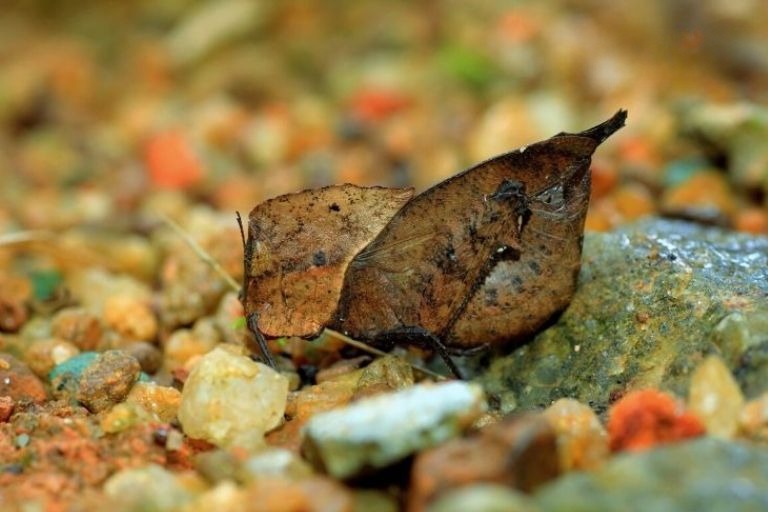
The Chorotypus saussure is the scientific name for the grasshopper commonly known as the “dead leaf” grasshopper. Its common name comes from the fact that its body looks like a dry brown leaf that has fallen from a tree or bush.
Dead leaf grasshoppers are able to convincingly imitate both living and decaying leaves. The body and wings of these creatures can be either green or brown, or a mixture of the two. The veins and pattern on the forewings are both inspired by leaves.
In addition, they are decorated with tiny notches meant to resemble the nibbles made by another type of herbivorous insect on leaves. The female ovipositor is extremely curved, and its saw-like tip is thick and sturdy.
However, in terms of its habitat, food, and life cycle, this insect is very similar to the common grasshopper and the locust.
Habitat
There is a high concentration of these insects in a bush of dead, dried leaves. The dead leaf grasshopper is native to countries in Eastern and Southern Asia due to the region’s dry climate, which is ideal for the species. And there are even bugs in Texas that mimic the appearance of real leaves.
Dietary Routines
To survive, dead leaf grasshoppers primarily feed on the plant’s leaves and sap. They aren’t partial to any one plant in particular, and will eat just about anything green.
Importance
The dead leaf grasshopper is a key player in decomposition processes. Because of this, these insects are effective at preventing forest or crop plant overgrowth.
These insects are the primary source of nutrition for many species of small birds. As a result, dead leaf grasshoppers play a crucial role in ensuring ecological stability.
2. Dead Leaf Butterfly/Leaf Mimicry Moth
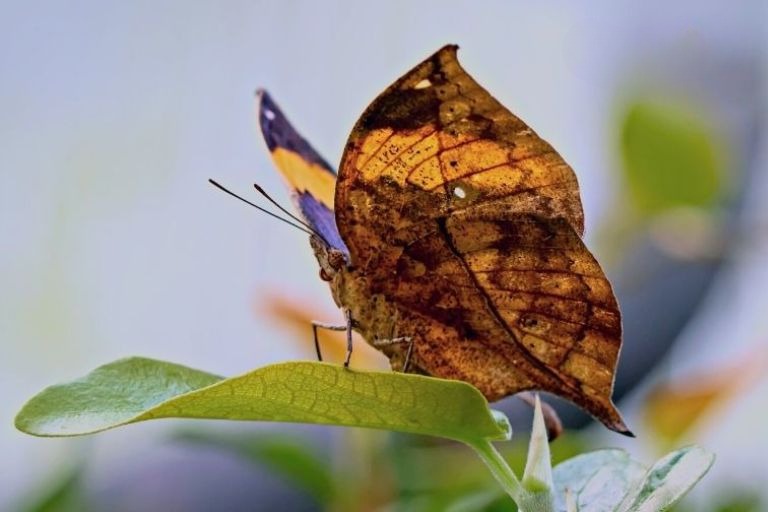
It’s been called both a dead leaf butterfly and a moth. The correct name, however, is oakleaf butterfly. The wings of this insect are graphically represented as a key component in the name.
The wings of this creature look almost exactly like a brown leaf that has fallen from a tree. Consequently, it is not possible to identify a butterfly when it is perched, either on the ground or a tree branch.
The orange oakleaf is another name for the bug that looks like an oak leaf; its scientific name is Kallima inachus. It can soar high and swiftly through dense forests thanks to its sturdy wings, which can withstand rain and wetness.
If threatened by birds, it will make erratic, rapid descents to the ground, where it will hide among the foliage while folding its wings to make itself appear smaller.
Habitat
The dead leaf butterfly will rest on the ground near fallen leaves or tree branches rather than on flowers. South Asia, Asia, and some parts of Africa and North America are good examples of warm, dry regions where you can find these bugs.
Dietary Routines
The orange oakleaf, also known as the dead leaf butterfly, subsists on decaying fruit and animal waste. It also occasionally consumes nectar and sap from flowers and plants.
Fascinating Information
The outer layer of the wings undergoes seasonal color changes. However, its outer wings amazingly mimic the pattern of a decaying leaf, while its inner wings are a riot of color.
Importance
Nature has made a stunning work of art with the orange oakleaf. It poses no risk to human health. Nonetheless, these insects play a crucial role in maintaining a healthy ecosystem.
This bug cleans up the environment by feasting on decaying plant matter and animal waste. Even better, this insect plays an important role in pollination.
3. Dead Leaf Mantis

Several species of mantis can successfully disguise themselves as dead leaves. Effective camouflage in the wild.
My personal favorite at the top of the camouflage tree is the dead leaf mantis, or “Deroplatys desiccata” (scientific name). Leaves that have dried out are called “desiccata,” which is Latin for “dried.”
Females are known for their distinctive leafy appearance. Having larger bodies and more extended wing flaps than the males is the reason why.
The males of this species resemble leaves less so than the females do because they need to be more aerodynamic when flying.
Anti-Attack Mechanism
When the mantis feels threatened, it will lie motionless on the floor with its legs spread or folded. The fact that it looks like a dry leaf aids in its ability to fool audiences.
They don’t respond to physical contact at all. They’ll suddenly get to their feet and start running. Adult “Deroplatys desiccata” can also perform what is called a “Deimatic Display,” in which they spread their wings in response to danger.
This kind of dramatic performance is meant to scare off potential predators. The mantis spreads its black-and-white-striped rear wings and its large black spotty front wings.
Habitat
This type of mantis, known as a “dead leaf mantis,” prefers to live in low-lying, wet areas. That’s why it thrives in Asia, particularly in Indonesia, Malaysia, and India.
Food
Crickets, locusts, and grasshoppers are among the prey of these carnivorous insects. Some species of praying mantis also prey on spiders and other small insects.
You Might Enjoy This Video, Too!
Frequently Asked Questions (FAQs)
What is the large bug that resembles a leaf?
The giant leaf insect, or bug leaf, is the insect (Pulchriphyllium giganteum), which resembles a young green leaf. It looks like a green leaf in every way: shape, pattern, and color.
What bug resembles a dried leaf?
The grasshopper, monarch butterfly, and tiger beetle are all insects that share the appearance of dried leaves. They are a crippled brown color, and their veins look like the veins of a dried-up leaf.
What do you call the bugs that look like leaves?
The Phylum Arthropoda is home to all those tiny green bugs that you might mistake for leaves. In contrast, the majority of these insects are members of the Phylliidae family and the Phasmatodea order.
How uncommon is a leaf bug?
The existence of a bug that can pass for a leaf is unusual and limited to specific regions. There is a specific environment that each species of leaf bug calls home. Generally speaking, you can find these bugs in the tropical regions of Asian and African countries.
Can leaf bugs harm you?
The leaf bug poses no threat to human health. Unlike most insects, they won’t sting or bite you. They mostly eat green leaves and flower nectar, so they don’t cause much damage to plants.
To Sum Up
The leaf bugs are a paradigm case of an organism defending itself against adversity through natural means. They contribute significantly to maintaining a healthy ecosystem and have minimal negative effects on other organisms and on humans.
Insects that can pass for leaves are highly sought after by breeders due to their rarity and distinctive features. As a result of your newfound knowledge, you can now breed and keep one of these insects as a pet.
We hope you found this article helpful in learning more about these insects with a leaf-like body plan.


